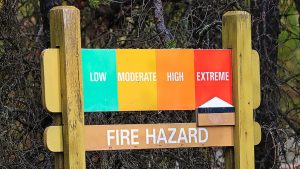Sitting up on the roof of his house, Royce Hamer could see the tornado heading his way.
DRAYTON
Sitting up on the roof of his house, Royce Hamer could see the tornado heading his way.
His biggest concern was for the houses, property and lives of his neighbours.
Hamer wasn’t concerned about his own house. It’s pretty well tornado proof.
His new home is composed of four steel-reinforced concrete domes buried in the side of a hill. It wasn’t protection from tornados that persuaded Hamer to build such an usual home. He was seeking protection from rising energy costs.
The August 18 tornado that demolished many homes, barns, cottages and thousands of large trees in Hamer’s neighbourhood near Lake Conestoga and Drayton, later touched down near Fergus and caused millions of dollars in damage.
And then came Katrina. One result of that devastating hurricane was a huge jump in fuel prices.
“I’ve always felt we could be building much more energy efficient homes here in Canada and stronger homes, too. This house will last for hundreds of years,” said Hamer, who works as a millwright in a Guelph manufacturing plant.
He’ll be heating his concrete home with radiant hot water heating in the concrete floors, plus two wood-burning stoves; one in the livingroom for esthetics and one in the garage for cooking. The water will be heated by propane.
“We don’t need air conditioning,” said Hamer. “The earth around the structure has a constant temperature of 55F, but there will be an air exchanger.”
Hamer expects his construction costs to be $329,000 and the four-acre rural lot cost $100,000. The concrete structure was built by Jay Scafe, who says it came in at about the same cost per square foot as a traditional stick-built house.
Scafe’s company, Terra-Dome Corporation, is located in Grand Valley, Missouri and he has built more than 600 similar domed concrete homes throughout the United States, the Virgin Islands and Australia.
This is Terra-Dome’s first project in Canada and Scafe plans to use Hamer’s home to demonstrate his company’s building techniques and plans.
“We’ve built some homes with 9,000 square feet and a shopping mall in Massachusetts with 30,000 square feet using 35 domes. Most of our homes are in the range of 2,300 square feet,” said Scafe, 41, who started building concrete dome homes with his father 25 years ago.
“The concrete dome design creates a roof 20 times stronger than a flat roof design,” said Scarfe. “We’ve had our dome homes go through an earthquake in Alaska that rated in the sevens on the Richter scale and there was no damage. We had a propane car explode in the garage of one of our houses. Nobody was hurt and only an interior wooden wall was blown out.
These homes stand up to fire, earthquakes, hurricanes, tornadoes and termites. We install an exterior draining system, both around the perimeter and up on the roof if it has an earth cover.”
Hamer’s 3,163-square-foot home has four domes, each with a 28-foot radius and 12-foot-high cathedral ceilings. “We don’t need any interior walls for support. That means we can create any configuration we want for our interior layout,” said Hamer.
The walls and roof are eight-inches thick and each dome is topped by a 6-foot-by-6-foot skylight. With a long wall of large windows looking southwest, plus the skylights, Hamer says his home has more natural light than most homes.
It took three months to build the Hamer home. Concrete is poured by Scafe’s Missouri-based crew at the housing site into a steel-reinforced dome-shaped frame that is supported by a hydraulic lift until the concrete hardens.
Cameron Ridsdale at the Cement Association of Canada says there’s often an increase in the construction of concrete-shell homes when energy prices are rising.
“They are usually more energy efficient than traditional stick-built homes . . .,” he said.










Recent Comments
comments for this post are closed